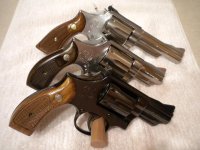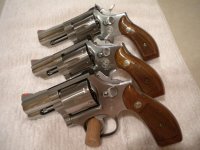In the 3 years I've been on this forum there have been just 2 postings about an MIM hammer spur breaking. On one the gun was dropped on concrete on the hammer spur and it snapped off.
I am also one who has no problem with MIM parts at all because manufacturers of high quality guns "know their stuff" and make it properly, and use it properly.
In many cases, I like the feel and fit of the MIM parts better.
When Smith starts using MIM barrels and cylinders, then I'll be concerned.

But to why I jumped in right here:
My wife's carry pistol was/is a Model 60 that I bought way back around 1980,
way before MIM.
Around '82, it slipped out of her purse while she was looking for something and it dropped onto a concrete floor, cleanly braking off the hammer spur about halfway.
The drop was "perfect", and nothing else at all was nicked or marred other than that
stainless hammer breaking off.
I carefully rounded the sharp nub with a Dremel tool and made it look like it was intentionally bobbed, and ever since then, my wife has preferred her "newly bobbed" Model 60 for purse carry.
The point is, MIM can break, stainless can break, forged can break. It all has to do with "suitability for purpose", and I've seen no abuse of that principle by any of the big name gun manufacturers, and as a result, we are getting
better guns at reasonable prices from them.
Nothing wrong with MIM at all. In fact, it's used a lot in the aircraft industry, so if you have a problem with MIM, you better not get on any airplanes ever again.





